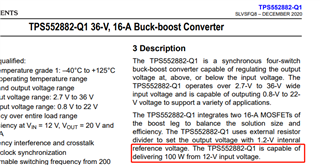Other Parts Discussed in Thread: , LM5176
Hi there,
we found TPS552882 maxim output current value is confusing.
1. In the product selection list, the table shows the maxim output current value is 6.35A, as below image.

2. But the Average inductor current limit in datasheet is 16.5A typical.
3. and in the description "The TPS552882-Q1 is capable of delivering 100 W from 12-V input voltage."

4. and there are many efficience test figures, from figure 6-1 to figure 6-10, the maxim output current is less than 8A.
5. the webench says the thermal issue would occur, when the output current exceed 6A.
we need this part output 15A, when the input voltage is from 9 to 16, and the output voltage is 12V.
Could this part meet our design goal?
the other question is what's the real value of Vsns, the spec descript the same condition with different value, as below image.


